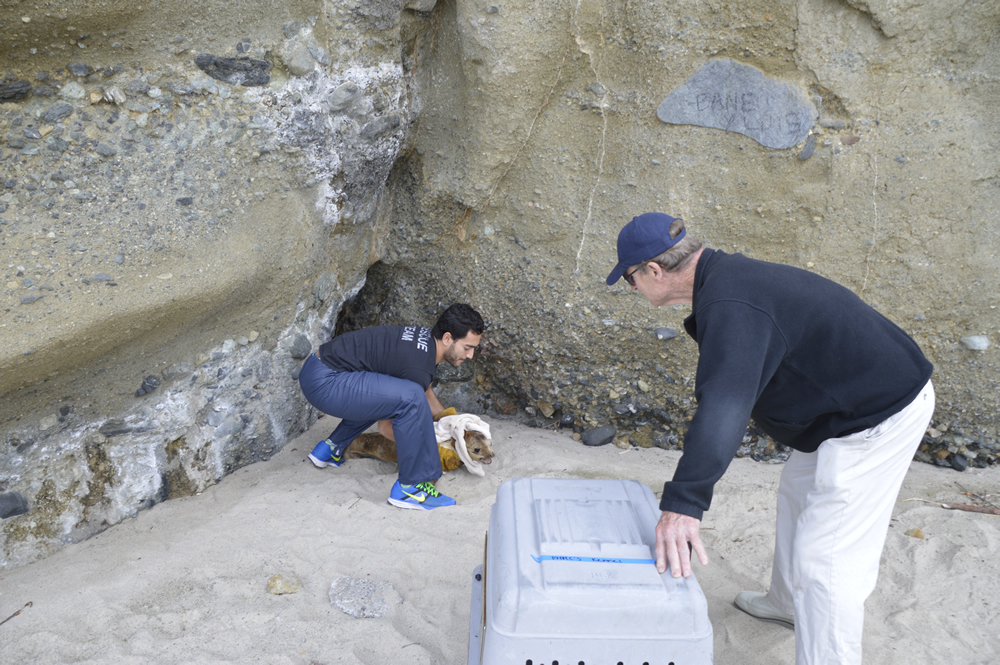
Once again the Pacific Marine Mammal Center in Laguna Beach is rescuing large numbers of distressed pinnipeds and is seeking financial help to replenish supplies needed to rehabilitate the animals.
“We are near capacity of 125-130 animals consistently,” said Keith Matassa, executive director of the center designated to rescue sea mammals along the entire Orange County coastline. “We are … releasing them as soon as they are at weight to make room,” he said. Most are malnourished and many are infected with parasites, he added.
This year’s strandings of sea lion pups and yearlings in January and February exceed that of 2014 and 2013, when the National Oceanic and Atmospheric Administration first declared an “unusual mortality event,” but the numbers are lower than the same period in 2015. Most of the strandings have occurred in the first four months of the year, much earlier and at much higher levels than the historic averages, said Jim Milbury, a NOAA spokesman in Long Beach.
In 2013, PMMC had 151 sick animals in its care. Initial speculation was that a lack food due to an El Nino weather pattern that brings warmer water moved sea lion prey to cooler waters. That would make it more difficult for mother sea lions to get adequate amounts of food and result in their inability to provide adequate milk to nourish their pups, causing premature weaning.
Sea lion pups are totally dependent on their mothers for the first six months of their life and are normally weaned at about 11 months of age. If the mothers had difficulty finding food, or had to travel further offshore to find food, then the pups may have tried to feed on their own before they were able, resulting in starvation, says NOAA’s website.
Besides weather patterns, the population of Pacific sardines, a favorite of sea lions, has plummeted by 90 percent since 2007, according to the Oceana Foundation, an ocean conservation advocate based in Washington, D.C.
Toby Garfield, director of research for NOAA’s South West Fisheries Science Center, said in a statement last year, “We are seeing unprecedented changes in the environment.”
Scientists at the National Marine Fisheries Service say higher temperatures on land and sea as well as ocean acidification due to carbon emissions are behind the changes.
A change is also evident among the sea mammals under care by the rescue center. The peak stranding season occurred later this year, thus the sea lions currently crowding PMMC’s pools are 8 to 9 months old, Matassa said.
Most of the center’s patients are California sea lions and northern elephant seals, along with other varieties of seals. “The rehabbing process is slower this year because the sea lions are coming in older and sicker,” Matassa said. “It costs between $2,500 and $3,000 to rehabilitate just one seal or sea lion.” Currently the facility is going through nearly 800 pounds of fish per day and 70 bottles of Pedialyte, used to hydrate critical patients.
The sea lion crises is reflected in PMMC’s rising expenses that jumped 58 percent in 2013, the most recent figures available, to almost $1.6 million amid the first unusual mortality event, compared to $1 million in 2012, according to Guidestar, a website that tracks non-profit finances.
About half of the pups rescued and rehabilitated survive and are released, NOAA says. Tracking data from satellite tags show most survive following release.
Matassa urges the public to call the center, 949 494-3050, if they see an animal that needs help. He cautions against approaching or pushing the animal back into the water. They have crawled out of the water to rest and get warm, he said.
Potential donors can contact the center at pacificmmc.org.





Hi There, I am seeing photos of dead/dying sea-lions with blood coming out of their eyes.
See here from Pepperdine University for example: http://pepperdine-graphic.com/wp-content/uploads/2016/03/IMG_2332-1024×768.jpg
Radiation sickness makes you bleed from your eyes.
Have any dead animals been tested for Fukushima-related radionuclides?
Thanks!
Fred
Its radiation from Fukishima; are you guys purposely ignoring the odvious? There is special place in hell for all of you, if you are purposely not testing these animals for radiation sickness
[…] Laguna Beach Independent, Apr 23, 2016: Most are malnourished and many are infected with parasites, [said Keith Matassa, Pacific Marine Mammal Center]… “The rehabbing process is slower this year because the sea lions are coming in older and sicker.” […]
[…] hold nations accountable for climate change, biologists in California were attempting to triage an influx of dying sea lions—victims of global warming—that had washed up on their […]
[…] hold nations accountable for climate change, biologists in California were attempting to triage an influx of dying sea lions—victims of global warming—that had washed up on their […]
[…] at West Street Beach spotted a young male elephant seal Saturday. Five beachgoers helped Pacific Marine Mammal Center animal rescue coordinator Malena […]
[…] years saw a massive stranding of sea lions of all ages along the coast. The Pacific Marine Mammal Center on Laguna Canyon Road […]